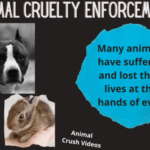In the digital age, social media platforms wield immense influence over public discourse, including the pressing issue of animal welfare. One such platform that has become a focal point for discussions surrounding animal rights is YouTube. With its extensive user-generated content, the question arises: Does YouTube allow animal cruelty videos? To answer this query, it is imperative to examine the platform’s policies, the nature of the content that populates its channels, and the broader implications on society.
The foundation of YouTube’s content moderation lies within a comprehensive set of community guidelines. These guidelines explicitly prohibit content that promotes or glorifies violence and cruelty toward animals. The platform defines “animal cruelty” as the infliction of unnecessary suffering or death upon animals. This encompasses a broad spectrum of behaviors, including but not limited to, the following:
- Physical Abuse: Videos depicting physical harm, such as beating or torturing animals, are strictly forbidden.
- Abandonment: Footage showcasing the neglect or abandonment of pets or other animals violates community standards.
- Fighting: Content glorifying animal fighting, including dogfighting or cockfighting, is unequivocally banned.
- Illegal Activities: Any content that captures or promotes illegal wildlife trade or exploitation falls under the umbrella of prohibited content.
Despite robust policies, the efficacy of content moderation can be questioned. YouTube employs algorithms and human moderators to enforce these regulations; yet, the sheer volume of uploads per minute—approximately 500 hours’ worth—creates considerable challenges in identifying and removing harmful content in a timely manner. Consequently, some animal cruelty videos may evade detection, creating potential avenues for disturbing content to permeate the platform.
Additionally, the platform must navigate the fine line between censorship and freedom of expression. This has led to debates regarding the categorization of certain videos. For instance, some content creators may attempt to frame cruel acts as “educational” or “awareness-raising,” complicating the assessment for moderators. Documentaries focusing on animal rights or environmental issues may contain graphic imagery intended to elicit an emotional response, leading to further ambiguity.
The advent of viral challenges and trends poses another dilemma. Some users create content that, while not overtly violent, may still compromise animal welfare in pursuit of entertainment. This can range from viral stunts that involve animals to pranks that may frighten or discomfort pets. These gray areas in content classification invite scrutiny and can lead to harmful ramifications for the animals involved.
Moreover, viewers must be discerning consumers of content. While YouTube’s algorithms often promote videos based on popularity rather than ethical standards, users play a pivotal role by reporting content that violates community guidelines. The collective effort of vigilant viewers can serve as a deterrent against the publication of animal cruelty videos.
In response to public outcry, particularly from animal welfare organizations and concerned citizens, YouTube has taken proactive steps to bolster its policies. Initiatives such as collaboration with advocacy groups aim to enhance awareness and provide resources for users to identify and report abusive content. Additionally, educational campaigns targeting creators may encourage ethical treatment of animals in their videos, fostering a culture of responsibility within the creator community.
It is essential to consider how the platform’s monetization policies intersect with issues of animal welfare. Content that garners substantial viewership may also attract advertisement revenue, inadvertently incentivizing creators to produce sensational or controversial material. This potential profit motive could contribute to the proliferation of animal cruelty videos, despite existing regulations. Consequently, platforms must evaluate how their monetization strategies may inadvertently create a marketplace for ethically questionable content.
In this context, it is also vital to address the role of viewers in shaping the content landscape. Audiences hold significant purchasing power; when they choose to support creators who adhere to ethical standards, they can encourage a shift away from exploitative content. By championing channels that prioritize animal welfare and report harmful practices, consumers can contribute to a more humane digital environment.
Ultimately, while YouTube has established policies against animal cruelty, the challenge lies in the persistence of harmful content and the platform’s ability to address it effectively. The responsibility does not rest solely with YouTube; it is a shared obligation among users, creators, and advocates to foster a culture where animal welfare is prioritized. With vigilance, education, and community engagement, it is possible to cultivate an online space that not only forbids cruelty but also champions the protection and humane treatment of all living beings.
As society continues to navigate the complexities of technology and ethics, it is crucial to remain steadfast in the commitment to animal rights, holding platforms accountable while simultaneously empowering individuals to drive positive change. While YouTube is just one medium, it symbolizes a broader need for vigilance in the fight against animal cruelty across all social media.








